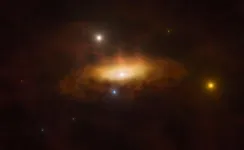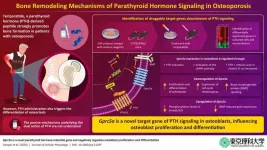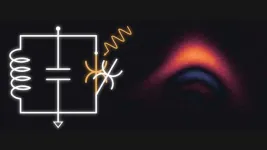(Press-News.org) In late 2019 the previously unremarkable galaxy SDSS1335+0728 suddenly started shining brighter than ever before. To understand why, astronomers have used data from several space and ground-based observatories, including the European Southern Observatory’s Very Large Telescope (ESO’s VLT), to track how the galaxy’s brightness has varied. In a study out today, they conclude that they are witnessing changes never seen before in a galaxy — likely the result of the sudden awakening of the massive black hole at its core.
“Imagine you’ve been observing a distant galaxy for years, and it always seemed calm and inactive,” says Paula Sánchez Sáez, an astronomer at ESO in Germany and lead author of the study accepted for publication in Astronomy & Astrophysics. “Suddenly, its [core] starts showing dramatic changes in brightness, unlike any typical events we've seen before.” This is what happened to SDSS1335+0728, which is now classified as having an ‘active galactic nucleus’ (AGN) — a bright compact region powered by a massive black hole — after it brightened dramatically in December 2019 [1].
Some phenomena, like supernova explosions or tidal disruption events — when a star gets too close to a black hole and is torn apart — can make galaxies suddenly light up. But these brightness variations typically last only a few dozen or, at most, a few hundreds of days. SDSS1335+0728 is still growing brighter today, more than four years after it was first seen to ‘switch on’. Moreover, the variations detected in the galaxy, which is located 300 million light-years away in the constellation Virgo, are unlike any seen before, pointing astronomers towards a different explanation.
The team tried to understand these brightness variations using a combination of archival data and new observations from several facilities, including the X-shooter instrument on ESO’s VLT in Chile’s Atacama Desert [2]. Comparing the data taken before and after December 2019, they found that SDSS1335+0728 is now radiating much more light at ultraviolet, optical, and infrared wavelengths. The galaxy also started emitting X-rays in February 2024. “This behaviour is unprecedented,” says Sánchez Sáez, who is also affiliated with the Millennium Institute of Astrophysics (MAS) in Chile.
“The most tangible option to explain this phenomenon is that we are seeing how the [core] of the galaxy is beginning to show (...) activity,” says co-author Lorena Hernández García, from MAS and the University of Valparaíso in Chile. “If so, this would be the first time that we see the activation of a massive black hole in real time.”
Massive black holes — with masses over one hundred thousand times that of our Sun — exist at the centre of most galaxies, including the Milky Way. “These giant monsters usually are sleeping and not directly visible,” explains co-author Claudio Ricci, from the Diego Portales University, also in Chile. “In the case of SDSS1335+0728, we were able to observe the awakening of the massive black hole, [which] suddenly started to feast on gas available in its surroundings, becoming very bright.”
“[This] process (...) has never been observed before,” Hernández García says. Previous studies reported inactive galaxies becoming active after several years, but this is the first time the process itself — the awakening of the black hole — has been observed in real time. Ricci, who is also affiliated with the Kavli Institute for Astronomy and Astrophysics at Peking University, China, adds: “This is something that could happen also to our own Sgr A*, the massive black hole (...) located at the centre of our galaxy," but it is unclear how likely this is to happen.
Follow-up observations are still needed to rule out alternative explanations. Another possibility is that we are seeing an unusually slow tidal disruption event, or even a new phenomenon. If it is in fact a tidal disruption event, this would be the longest and faintest such event ever observed. “Regardless of the nature of the variations, [this galaxy] provides valuable information on how black holes grow and evolve,” Sánchez Sáez says. “We expect that instruments like [MUSE on the VLT or those on the upcoming Extremely Large Telescope (ELT)] will be key in understanding [why the galaxy is brightening].”
Notes
[1] The SDSS1335+0728 galaxy’s unusual brightness variations were detected by the Zwicky Transient Facility (ZTF) telescope in the US. Following that, the Chilean-led Automatic Learning for the Rapid Classification of Events (ALeRCE) broker classified SDSS1335+0728 as an active galactic nucleus.
[2] The team collected archival data from NASA’s Wide-field Infrared Survey Explorer (WISE) and Galaxy Evolution Explorer (GALEX), the Two Micron All Sky Survey (2MASS), the Sloan Digital Sky Survey (SDSS), and the eROSITA instrument on IKI and DLR’s Spektr-RG space observatory. Besides ESO’s VLT, the follow-up observations were conducted with the Southern Astrophysical Research Telescope (SOAR), the W. M. Keck Observatory, and NASA’s Neil Gehrels Swift Observatory and Chandra X-ray Observatory.
More information
This research was presented in a paper entitled “SDSS1335+0728: The awakening of a ∼ 106M⊙ black hole” published in Astronomy & Astrophysics.
The team is composed of P. Sánchez-Sáez (European Southern Observatory, Garching, Germany [ESO] and Millenium Institute of Astrophysics, Chile [MAS]), L. Hernández-García (MAS and Instituto de Física y Astronomía, Universidad de Valparaíso, Chile [IFA-UV]), S. Bernal (IFA-UV and Millennium Nucleus on Transversal Research and Technology to Explore Supermassive Black Holes, Chile [TITANS]), A. Bayo (ESO), G. Calistro Rivera (ESO), F. E. Bauer (Instituto de Astrofísica, Pontificia Universidad Católica de Chile, Chile; Centro de Astroingeniería, Pontificia Universidad Católica de Chile, Chile; MAS; and Space Science Institute, USA), C. Ricci (Instituto de Estudios Astrofísicos, Universidad Diego Portales, Chile [UDP] and Kavli Institute for Astronomy and Astrophysics, China), A. Merloni (Max-Planck-Institut für Extraterrestrische Physik, Germany [MPE]), M. J. Graham (California Institute of Technology, USA), R. Cartier (Gemini Observatory, NSF National Optical-Infrared Astronomy Research Laboratory, Chile, and UDP), P. Arévalo (IFA-UV and TITANS), R.J. Assel (UDP), A. Concas (ESO and INAF - Osservatorio Astrofisico di Arcetri, Italy), D. Homan (Leibniz-Institut für Astrophysik Potsdam, Germany [AIP]), M. Krumpe (AIP), P. Lira (Departamento de Astronomía, Universidad de Chile, Chile [UChile], and TITANS), A. Malyali (MPE), M. L. Martínez-Aldama (Astronomy Department, Universidad de Concepción, Chile), A. M. Muñoz Arancibia (MAS and Center for Mathematical Modeling, University of Chile, Chile [CMM-UChile]), A. Rau (MPE), G. Bruni (INAF - Institute for Space Astrophysics and Planetology, Italy), F. Förster (Data and Artificial Intelligence Initiative, University of Chile, Chile; MAS; CMM-UChile; and UChile), M. Pavez-Herrera (MAS), D. Tubín-Arenas (AIP), and M. Brightman (Cahill Center for Astrophysics, California Institute of Technology, USA).
The European Southern Observatory (ESO) enables scientists worldwide to discover the secrets of the Universe for the benefit of all. We design, build and operate world-class observatories on the ground — which astronomers use to tackle exciting questions and spread the fascination of astronomy — and promote international collaboration for astronomy. Established as an intergovernmental organisation in 1962, today ESO is supported by 16 Member States (Austria, Belgium, Czechia, Denmark, France, Finland, Germany, Ireland, Italy, the Netherlands, Poland, Portugal, Spain, Sweden, Switzerland and the United Kingdom), along with the host state of Chile and with Australia as a Strategic Partner. ESO’s headquarters and its visitor centre and planetarium, the ESO Supernova, are located close to Munich in Germany, while the Chilean Atacama Desert, a marvellous place with unique conditions to observe the sky, hosts our telescopes. ESO operates three observing sites: La Silla, Paranal and Chajnantor. At Paranal, ESO operates the Very Large Telescope and its Very Large Telescope Interferometer, as well as survey telescopes such as VISTA. Also at Paranal ESO will host and operate the Cherenkov Telescope Array South, the world’s largest and most sensitive gamma-ray observatory. Together with international partners, ESO operates ALMA on Chajnantor, a facility that observes the skies in the millimetre and submillimetre range. At Cerro Armazones, near Paranal, we are building “the world’s biggest eye on the sky” — ESO’s Extremely Large Telescope. From our offices in Santiago, Chile we support our operations in the country and engage with Chilean partners and society.
Links
Research paper
Photos of the VLT
Find out more about ESO's Extremely Large Telescope on our dedicated website and press kit
For journalists: subscribe to receive our releases under embargo in your language
For scientists: got a story? Pitch your research
Contacts
Paula Sánchez Sáez
European Southern Observatory (ESO)
Garching bei München, Germany
Tel: +49 89 3200 6580
Email: Paula.SanchezSaez@eso.org
Lorena Hernández García
Millennium Institute of Astrophysics (MAS)
Santiago, Chile
Email: lorena.hernandez@uv.cl
Claudio Ricci
Diego Portales University
Santiago, Chile
Email: claudio.ricci@mail.udp.cl
Bárbara Ferreira
ESO Media Manager
Garching bei München, Germany
Tel: +49 89 3200 6670
Cell: +49 151 241 664 00
Email: press@eso.org
END
Astronomers see a massive black hole awaken in real time
2024-06-18
ELSE PRESS RELEASES FROM THIS DATE:
A review and update on therapy of gastrointestinal tract tumors: from the bench to clinical practice
2024-06-18
Gastrointestinal (GI) cancers, encompassing esophageal, gastric, small bowel, and colorectal carcinomas, represent a significant global health burden due to their high incidence and mortality rates. This review by M. Jesús Fernández-Aceñero et al. provides an in-depth analysis of the molecular characteristics, prognosis, and current therapeutic strategies for these malignancies, highlighting the latest advancements and challenges in the field.
Esophageal carcinoma is among the ten most prevalent tumors globally, with squamous cell carcinoma (SCC) being the most common subtype. ...
Study suggests hepatitis E may be a sexually transmitted infection
2024-06-18
COLUMBUS, Ohio – Discovering that hepatitis E virus is associated with sperm in pigs suggests the virus may be both sexually transmitted and linked to male infertility, according to a new study.
Hepatitis E (HEV) is the leading cause of the acute viral liver infection in humans worldwide, mostly in developing regions where sanitation is poor. The virus is also endemic in pigs in the United States – though it is present mostly in organs rather than muscle, and is killed when the meat is cooked.
Because HEV has been linked to fatal pregnancy complications and reports of male infertility ...
Investigating the causes of fetal growth disorders
2024-06-18
Common complications of pregnancy affecting fetal size may be caused by irregularities in the transport of amino acids across the placenta—a finding with therapeutic implications. Intrauterine growth restriction (IUGR) and fetal overgrowth affect 15-20% of pregnancies worldwide. Abnormal fetal growth is strongly linked to the development of obesity, diabetes, and cardiovascular disease in later life. Placental transport of essential amino acids is decreased in human IUGR and increased in fetal overgrowth, but whether this was a cause or consequence was unclear. Fredrick Rosario-Joseph and colleagues created a line of mice ...
Enzymes instead of cyanide: Researchers develop biocatalytic process for nitrile production
2024-06-18
If the household cleaner emits a lemon-like odour, this may be due to a nitrile called citronellyl nitrile. These versatile chemical nitrile groups are also used in the manufacture of active pharmaceutical ingredients, superglue and chemical-resistant gloves. The prevalent production process used so far has required a chemical reaction of certain molecules with highly toxic cyanide. Margit Winkler from the Institute of Molecular Biotechnology at TU Graz, together with Ludmila Martínková from the Institute of Microbiology at the Czech Academy of Sciences, ...
New study reveals promising drug target for treating osteoporosis
2024-06-18
Osteoporosis is a skeletal condition that leads to the weakening of bones, making them porous, fragile, and prone to breakage. A whopping 8.9 million fractures are caused by osteoporosis annually, with one fracture occurring every three seconds! The aging population is the most vulnerable to primary osteoporosis, given, their frailty, and often, requires long-term therapy and support. Advances in healthcare and the corresponding rise in the aging population have put a strain on available resources, underscoring the need for effective therapies against osteoporosis.
Induction of parathyroid hormone (PTH) signaling using the PTH-derived ...
Breakthrough may clear major hurdle for quantum computers
2024-06-18
The potential of quantum computers is currently thwarted by a trade-off problem. Quantum systems that can carry out complex operations are less tolerant to errors and noise, while systems that are more protected against noise are harder and slower to compute with. Now a research team from Chalmers University of Technology, in Sweden, has created a unique system that combats the dilemma, thus paving the way for longer computation time and more robust quantum computers.
For the impact of quantum computers to be realised in society, quantum researchers first need to deal with some major obstacles. So far, errors and noise stemming from, for example, ...
Authority's physical proximity means greater obedience. New look at results of famous experiment
2024-06-18
Who should be spared pain, hurt or disappointment, and who should be harmed? This internal dilemma accompanied the participants of the Milgram experiment, say experts from SWPS University. They have revisited the causes of obedience in that famous study and showed that the experimenter's physical proximity promote subjects' obedience, while the learner's physical proximity decreases it.
American social psychologist Stanley Milgram's demonstration of the human tendency to show extreme obedience to authority was one of the most ...
Large wildfires create weather that favors more fire
2024-06-18
A new UC Riverside study shows soot from large wildfires in California traps sunlight, making days warmer and drier than they ought to be.
Many studies look at the effect of climate change on wildfires. However, this study sought to understand the reverse — whether large fires are also changing the climate.
“I wanted to learn how the weather is affected by aerosols emitted by wildfires as they’re burning,” said lead study author and UCR doctoral candidate James Gomez.
To find his answers, Gomez analyzed peak fire days and ...
Election administration performance linked to counties’ economic, racial makeup
2024-06-18
PULLMAN, Wash. – Voters who are neither wealthy nor white are more likely to live in counties with fewer resources available to make sure ballots are counted on time, a new election index revealed.
Researchers developed the County Election Administration index, detailed in the Election Law Journal, to evaluate election performance by county rather than just by state. Election administration encompasses the policies and processes that ensure election access, integrity and accuracy. Despite voter fraud claims in the last presidential election, researchers found that overall election performance ...
Blood markers detect rare forms of dementia as well as the neurological diseases ALS and PSP
2024-06-18
In a study with 991 adults, scientists at DZNE show that the most common forms of frontotemporal dementia (FTD) as well as the neurological diseases amyotrophic lateral sclerosis (ALS) and progressive supranuclear palsy (PSP) can be recognised by blood testing. Their procedure is not yet ready for routine medical use, but in the long term it could facilitate disease diagnosis and advance the development of new therapies already now. The findings published in the journal “Nature Medicine” are based ...





